Saxena Varsha1, Srivastava Niraj2* and Singh Lakshman3
and Singh Lakshman3
1Department of Shalya Tantra, Uttarakhand Ayurved University, Main campus, Harrawala, Dehradun, Uttarakhand
2Department of Kaumarbhritya/Bal-Roga, Sardar Patel Institute of Ayurvedic Medical Sciences and Research Centre. Lucknow, Uttar Pradesh
3Department of Shalya Tantra, Faculty of Ayurveda, Institute of medical sciences, Banaras Hindu University, Varanasi Uttar Pradesh
Corresponding Author E-mail: nirajimsbhu@gmail.com
DOI : https://dx.doi.org/10.13005/bpj/1891
Abstract
Anorectal diseases are the group of diseases which are usually neglected by general surgeons and physician. Kshara sutra, a gift of Ayurveda to the world, is well known therapy for these notorious ano-rectal diseases. Udumber Kshara Sutra is very effective in treatment of ano rectal diseases and has no complications. All parts of Ficus racemosa are medicinally important in traditional system of medicine in India. Main aim of this study is to present an overview of standard operative procedure (SOP) for Udumber stem bark Kshara sutra and its phytopharmacological review.The standard operating procedure of Udumber stem bark Kshara sutra preparation is documented from authors own observations and Information of phyto-constituents and pharmacological activity of components of Udumber (Ficus racemosa) was gathered from various published work of last ten years.Standard operating procedure (SOP) of Udumber Ksharasutra includes collection of udumber (Ficus racemosa) stem bark, Preparation of aqueous extracts of Udumber stem bark, preparation, packing and storage of Kshara Sutra. Many researches show that Udumber plant has multiple pharmacological activities such as anti-inflammatory and antibacterial etc.Ksharasutra is a unique cost effective parasurgical therapy effective in various ano-rectal diseases with a high rate of success and least chance of recurrence. Standard operating procedure (SOP) of Udumber Ksharasutra helps the physicians to develop quality product for commercial use and easy availability. Udumber plant has multiple pharmacological activities.
Keywords
Anorectal Diseases; Ayurveda; Psychopharmacology; SOP; Udumber Ksharasutra
Download this article as:| Copy the following to cite this article: Varsha S, Niraj S, Lakshman S. Standard Operative Procedure (SOP) for Udumber Stem Bark Kshara Sutra and its Phytopharmacological Appraisal. Biomed Pharmacol J 2020;13(1). |
| Copy the following to cite this URL: Varsha S, Niraj S, Lakshman S. Standard Operative Procedure (SOP) for Udumber Stem Bark Kshara Sutra and its Phytopharmacological Appraisal. Biomed Pharmacol J 2020;13(1). Available from: https://bit.ly/3cRrUZF |
Introduction
Ayurveda is the “Science of Life”, which helps in achieving a longer life span by preventing the occurrence of diseases as well as curing it to the possible extent if occurred. Plants have been known to cure various diseases in Ayurveda. According to an estimate of the World Health Organization (WHO), about 80% of the world population still uses herbs and other traditional medicines for fulfilling their primary health care needs. [1] Therefore, it is the need of today, to evaluate and characterize various plants and plant constituents against a number of diseases based on their traditional claims of the plants given in Ayurveda. Anorectal disorders are a group of medical disorders that occur at perianal and the junction of the anal canal and the rectum. These disorders are commonly encountered in general surgical practice. Patients with diseases of the anus and rectum are some of the most miserable people in the world. Anorectal disorders are common, and their prevalence in the general population is probably much higher than that seen in clinical practice as most patients do not seek medical attention. These affect men and women of all ages. Kshara sutra, a gift of Ayurveda to the world, is well known therapy for these notorious ano-rectal diseases. It is para-surgical and minimally invasive procedure for the treatment of ano-rectal disorders which affecting large numbers of people. [2] Kshara sutra needs no hospitalization & minimal hospital expenditure. Ksharasutra is safe and can be considered as better than conventional. Surgery. [3] Complete and detail descriptions of Ksharasutra are not available in Sushruta Samhita. But Acharya Sushruta mentioned that Kshara karma is very effective in management of anorectal disorders. [4] The present form of Ksharasutra was developed in department of Shalya Tantra at Banaras Hindu University initiated by Dr. P. S. Shankaran and later scientifically established by Prof. P. J. Deshpande through several researches in this area. The process of development of Kshara sutra was supported in the department by Prof. K. R. Sharma, Prof. G. C. Prasad, Prof. S. N. Pathak etc. [5] At this moment Kshara sutra therapy has been accepted globally and has emerged as a gold standard treatment for ano-rectal diseases. [6] The Indian Council of Medical Research (ICMR) found that, the recurrence of anal fistula by Ksharasutra was only 4% as compared to the 11% in patients who treated by conventional surgery. [7] Ksharasutra is very effective due to its antimicrobial, anti-inflammatory action and Tridoshaghna (pacifies all the three biohumors) properties. [8] At present many Ksharasutras are used clinical practice such as Snuhi Ksharasutra, Guggulu Ksharasutra, Udumber latex Ksharasutra etc. are used. Udumber Kshara Sutra is very effective in reducing pain, burning sensation, wound healing and tenderness in spite of higher UCT (unit cutting time) because of Snigdha, Laghu Guna, Kashaya Rasa and Sheeta Virya. It did not produce any complications like burning sensation and abscess formation in the postoperative period. [9]
The International Council for Harmonisation (ICH) defines SOPs for clinical research as “detailed, written instructions to achieve uniformity in the presentation of a specific function”. SOPs usually get applied in pharmaceutical processing and related clinical studies. From various parts of Udumber (Ficus racemosa) many active constituents have been isolated and possess useful pharmacological activities. All parts of Ficus racemosa are medicinally important in traditional system of medicine in India and have been used extensively in many systemic disorders. Experimental studies have demonstrated the anti-inflammatory, hepatoprotective, hypoglycemic and hypolipidemic effects of Ficus racemosa. [10] E. coli was found responsible for the infection which was proved in the pus culture report of the majority of the studies and Udumber ksharasutra was found effective on E Coli. [11] [12]
Aim and Objective
The main aim of this study is to present an overview of standard operative procedure (SOP) for Udumber stem bark Kshara sutra and its phyto-pharmacological review.
Material and Method
The standard operating procedure of Udumber stem bark Kshara sutra preparation is documented from authors own observations and Information of phyto-constituents and pharmacological activity of components of Udumber (Ficus racemosa) was gathered from Ayurvedic literatures and various published work of last ten years. The gathered data is documented, analyzed and arranged in a systematic manner.
Standard Operative Procedure (SOP) of Udumber Stem Bark Kshara Sutra Preparation
In India, the Department of AYUSH, Government of India, has launched a central scheme to develop standard operating procedures for the manufacturing process to develop pharmacopeial standards for Ayurvedic preparations. Here SOP of Udumber stem bark Kshara Sutra preparation has been explained in brief. Standard operating procedure (SOP) is a set of step-by-step instructions compiled by an organization to help workers carry out complex routine operations. Main aim of Standard Operative Procedure (SOP) is to achieve efficiency, quality output and uniformity of performance.
Observation and Result
Collection of Materials
Udumber (Ficus racemosa) stem bark have been identified and collected from the garden, Barbour thread on which Kshara sutra had been prepared was purchased from outside (market).
Udumber (Ficus Racemosa) Stem Bark
The Udumber stem bark used for the preparation of Kshara sutra was peeled off from the tree. The collected stem bark was thoroughly washed, weighed and dried. Finally extract was prepared and stored in air tight container for future use. 1 kg of stem bark was collected and thoroughly washed with water to remove adhering debris followed by rinsing with distilled water. Then it was spread in thin layers in stainless steel trays and dried under shade. After drying, the materials were grounded in a mechanical grinder and the resulting powder was passed through sieve No. 60 to obtain uniform coarse powder. The coarse powder was kept in polythene jars and used for extraction. [13] 10 g of air-dried powder was added to distilled water and boiled on slow heat for 2 h. It was then filtered through 8 layers of muslin cloth and centrifuged at 5000g for 10 min. The supernatant was collected. This procedure was repeated twice. After 6 hours, the supernatant collected at an interval of every 2 hours was pooled together and concentrated to make the final volume one-fourth of the original volume. [14] It was then autoclaved at 121°C and at 15 lbs pressure and stored at 4°C.
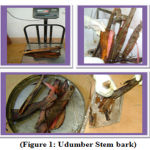 |
Figure 1 |
Sutra (Thread)
The aim and object of the use of thread, is the absorption of medicinal properties properly to be taken for the treatment. Thus the selection of thread should be perfect. The thread should be of good tensile strength, with well absorption capacity. It means that even after all procedure of Kshara-sutra formation; the thread should remain in a good tensile strength. Thus the Barbour thread no.20 was used for preparation of Udumber Ksharasutra and it is standardized by different workers with regards to its tensile strength and better accessibility.
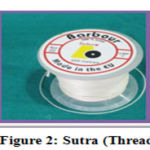 |
Figure 2 |
Preparation of Aqueous Extracts of Udumber Stem Bark
Dissolution
1000g of small pieces was dissolved in 4 liters of distilled water and taken in a stainless steel container.
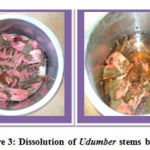 |
Figure 3 |
Boiling
Boiled on slow heat till one-fourth of the original volume and stirred intermittently with a glass rod stirrer.
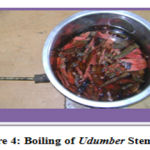 |
Figure 4 |
Filtration
Solution was filtered through Whatmann’s filter paper with pore size 615 A. Filtrate was collected in calibrated glass container and measured. It was kept in oven at 40°C till dryness.
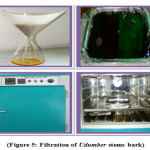 |
Figure 5 |
Storage
Dried extract was taken and grounded. Weighed and stored in airtight container in incubator (at 40oC)
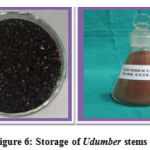 |
Figure 6 |
Preparation of Kshara Sutra
Preparation of hanger
Pre designed, rectangle shaped Epoxy coated Aluminum hanger (about 30×30 cm) was taken with small cuts made along a pair of its opposite edges at equal intervals and 20 no. linen Thread is wrapped on hanger tightly passing through the cuts made along its e edges.
 |
Figure 7 |
Coating
Udumber stem bark extract mix with distilled water in ratio of 1:2 to make thick paste. Hanger was placed obliquely along the stand. Udumber paste was taken in a petridish or small bowl. Clean gauze piece is dipped in Udumber paste is smeared over thread uniformly using gauze piece. Hanger is kept in Kshara-sutra drying cabinet at 40oC till the coating dries. Same procedure is repeated for 11 times.
 |
Figure 8 |
Packing of Kshara Sutra
Kshara sutra was cut into 30 cm pieces and dried in oven at 40oC and sealed in glass tubes. It was stored in incubator at 40oC. Stainless steel vessels used are of grade 304 stainless steel. Glass wares used are of borosilicate glass.
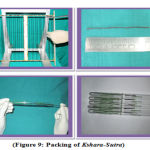 |
Figure 9 |
Phytopharmacological Property of Udumber
Ficus racemosa Linn. (Moraceae) is an important medicinal plant in India and popularly known as ‘gular’. The active constituent from Udumber leaves and stem bark is β-sitosterol which has good anti-diabetic action. Udumber plant has multiple pharmacological activities that include anti-inflammatory, antibacterial, anti-diabetic, antioxidant, anti-diarrheal, antipyretic, anti-fungal, hypolipidemic, and hepatoprotective activity. [15] [16 All parts of Ficus racemosa are medicinally important in traditional system of medicine in India and have been used extensively in many systemic disorders.
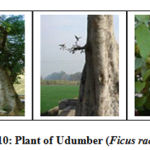 |
Figure 10 |
Root
It is used in dysentery, pectoral complaints, and diabetes, applied in mumps, other inflammatory, glandular enlargements and hydrophobia. In Sri Lankan indigenous system of medicine, it is used in the treatment of skeletal fracture.[17]
Bark
Ficus racemosa stem bark contains phytochemical constituents namely alkaloids, carbohydrates, flavonoids, glycosides, saponins, steroids, tannins, phenols and triberpenoids It is highly efficacious in threatened abortion and also recommended in urological disorders, diabetes, leprosy, dysentery, asthma and piles, antiseptic, antipyretic and vermicidal and the decoction of bark is used in the treatment of various skin diseases, ulcers. The astringent nature of the bark has been employed as a mouth wash in spongy gum and also internally in dysentery, menorrhagia and haemoptysis. [18] It is also used as a poultice in inflammatory swellings/boils and regarded to be effective in the treatment of piles, dysentry, asthma, gonorrhea, menorrhagia, leucorrhea, hemoptysis and urinary diseases. [19] Apart from the usage in traditional medicine, scientific studies indicate F. racemosa to possess various biological effects such as hepato-protective [20], chemo-preventive [21], anti-diabetic [22], anti-inflammatory [23], antipyretic [24], anti-tussive [25] and anti-diuretic. [26] The bark has also been evaluated for cytotoxic effects using 1BR3, Hep G2, HL-60 cell lines and found to be safe and less toxic than aspirin, a commonly consumed anti-inflammatory drug. [27]
Leaf
Leaves are useful in dysentery and diarrhea. The infusion of bark and leaves is also employed as mouth wash and internally in dysentery, menorrhagia, and effective remedies in glandular swelling, bronchitis, abscess, chronic wounds, cervical adenitis, hemorrhage and hemoptysis. Tender leaves are used in bilious affection and also to improve skin complexion. A decoction of leaves is a good wash for wound and ulcer.[28] The leaves powdered and mixed with honey is given in bilious infections.
Fruit
Tender fruits are astringent, stomachic, refrigerant, dry cough, loss of voice, disease of kidney and spleen, astringent to bowel, styptic, tonic, useful in the treatment of leucorrhoea. They are useful in miscarriage, spermatorrhoea, epididymitis, cancer, myalagia, scabies, haemoptysis, intrinsic hemorrhage, excessive thirst, visceral obstructions. It is believed to be a good remedy for visceral obstructions and extract of the fruit is used in leprosy, diarrhea, circulatory and respiratory disorders and menorrhagia. [29]
Latex
It is aphrodisiac and administered in hemorrhoids, diarrhea, and diabetes, alleviates the edema in adenitis, parotitis, or orchitis, traumatic swelling, toothache and vaginal disorders.[30]
Biological Activity
Several species belonging to the genera of Ficus were reported to contain furanocoumarins which is an important plant phototoxins.[31] Antioxidants from figs can protect lipoproteins in plasma from oxidation and produce a significant increase in plasma antioxidant capacity.[32]
Ethnomedicinal Information
Ficus racemosa stem bark showed antibacterial activity and have active response on Bacillus subtilis and E. coli. Ficus racemosa stem bark extract have potent Antioxidant and a probable natural radioprotector. [33]
Conclusion
Anorectal disorders are a group of medical disorders that occur at perianal and the junction of the anal canal and the rectum. Ksharasutra is a unique cost effective parasurgical therapy effective in various ano-rectal diseases with a high rate of success and least chance of recurrence. Various researches proved that Udumber Ksharasutra has antibacterial, antioxidant, anti-fungal, anti-inflammatory & wound healing properties. Standard operating procedure (SOP) of Udumber Ksharasutra helps the physicians and manufacturers to develop quality product for commercial use and easy availability. Standard operating procedure (SOP) of Udumber Ksharasutra includes collection of udumber (Ficus racemosa) stem bark, Preparation of aqueous extracts of Udumber stem bark, preparation, packing and storage of Kshara Sutra. Many researches shows that Udumber plant has multiple pharmacological activities that include anti-inflammatory, antibacterial, anti-diabetic, antioxidant, anti-diarrheal, antipyretic, anti-fungal, hypolipidemic, and hepatoprotective activity.
Acknowledgement
I acknowledged the Uttarakhand Ayurveda University (Main campus), Harrawala, (Dehradun), Uttarakhand, for providing library facility.
Source of support
Nil
Conflict of Interest
The authors declare that they have no conflict of interest.
Ethical Approval
No ethical approval is required as no animals or humans have been used in the study.
References
- World Health Organization,WHO 2012.http://www. who.int/research/en
- K Sharma, KR Sharma, K. Singh. Ksharsutra Therapy in Fistula –in-ano and other Ano-Rectal disorders, Rashtriya Ayurveda Vidyapeeth, New Delhi, 1995
- L .D. Barik , K.K.Ratha , M.Das and J. Hazra; Ksharsutra – A Phytopharmacological Appraisal and Method of Preparation; IJGHC, June 2015 – August 2015; Sec. B; Vol.4, No.3, 222-229.
- Panigrahi HK, Rani R, Padhi MM, Lavekar GS. Clinical evaluation of ksharasutra therapy in the management of Bhagandara (fistula in-ano) a prospective study. Anc Sci Life 2009; 28:29-35.
- Saxena V, Singh L. A comparative study of three different types of kshara sutras in the management of bhagandara (Fistula in Ano). Int J Ayurveda Med Sci 2017; 2: 54-8.
CrossRef - Sahu M. A Mannual on Fistula in Ano and Kshara Sutra Therapy. 1st ,Vol.1. Varanasi, India: National Resource: Centre on Kshara Sutra Therapy; 2015.
- Multicentric randomized controlled clinical trial of ksharasootra (Ayurvedic medicated thread) in the management of fistula-in-ano. Indian council of medical research. Indian J Med Res 1991; 94: 177-85.
- Biswas TK, Mukherjee B. Plant medicines of Indian origin for wound healing activity: a review. Int J Low Extreme Wounds 2003; 2:25-39.
CrossRef - Saxena V, Singh L. A Comparative Study of Three Different Types of Kshara Sutras in the Management of Bhagandara (Fistula in Ano). Int J Ayurveda & Med Sc 2017; 2(3): 54-58.
CrossRef - Kirtikar KR, Basu BD. Indian Medicinal Plants, (Vol. III), (reprinted edition). L.M. Basu (edition). Allahabad; 2327-2328; 1998.
- Varsha Saxena, L Singh, M. Sahu. “Standardized Kshar Sutra for Anorectal diseases, Publisher: www.lulu.com, Raleigh, North Carolina, USA, ISBN: 580-01-28054-02-3.
- Mandal SC, Maity TK, Das J, Saba BP, Pal M. Anti-inflammatory evaluation of Ficus racemosa Linn. leaf extract. J Ethnopharmacology 2000; 72: 87-92.
CrossRef - Kumar Dinesh, Kumar Ajay and Kumar, Prakash Om. Pharmacognostic evaluation of stem bark of Pongamia pinnata (L.) Pierre, Asian Pacific Journal of Tropical Biomedicine, S 543-S546. 2012.
CrossRef - WHO guidelines for Quality Control Methods for Medicinal Plant Materials. Pp. 28-30. Geneva, 1998.
- Chopra RN, Nagar SL, Chopra IC. New Delhi, India: Central Scientific and Industrial Research; 1986. Glossary of Indian medicinal plants, reprinted edition; p. 119.
- Atal CK, Kapur BM: Regional Research laboratory CSIR; 1982. Cultivation and Utilization of medicinal plants; pp. 514–9. Jammu-Tawi, India
- Mitra R. Bibliography on Pharmacognosy of Medicinal Plants, National Botanical Research Institute: Lucknow; 249-250; 1985.
- Chopra R N, Chopra I C, Handa K L, Kapur L D; Indigenous Drugs of India, 2nd ed, Academic Publisher, Calcutta,1958, pp. 508-674.
- Nadkarni K M, Nadkarni A K, Chopra R N; Indian Materia Medica, Vol. I, Popular Prakashan, Bombay, 1976, pp. 548-550.
- Mandal S C, Tapan K, Maity J, Das M, Pal M, Saha B P; Hepato-protective activity of Ficus racemosa leaf extract on liver damage caused by carbon tetrachloride in rats. Res., 1999, 13: (5) 430-432.
CrossRef - Khan N, Sultana S; Chemomodulatory effect of Ficus racemosa extract against chemically induced renal carcinogenesis and oxidative damage response in Wistar rats. Life Sci., 2005, 29, 1194-1210.
CrossRef - Rao B R, Murugesan T, Sinha S, Saha B P, Pal M, Mandal S C; Glucose lowering efficacy of Ficus racemosa bark extract in normal and alloxan diabetic rats. Res., 2002, 16, 590-592.
CrossRef - Mandal S C, Saha B P and Pal M; studies on bacterial activity of Ficus racemosa leaf extract, phytother Res, 2000, 14(4)278-280.
CrossRef - Rao B R, Anipama K, Swaroop A, Murugesan T, Pal M, Mandal S C; Evaluation of anti-pyretic potential of Ficus racemosa Phytomedicine, 2002, 9,731-733.
CrossRef - Rao B R, Murugesan T, Pal M, Saha B P, Mandal S C; Anti-tussive potential of methanol extract of stem bark of Ficus racemosa Phytother. Res., 2003, 17, 1117- 1118.
CrossRef - Ratnasooriya W D, Jayakody J R, Nadarajah T; Antidiuretic activity of aqueous bark extract of Sri Lankan Ficus racemosa in rats. Acta Biol Hung. 2003, 54(3-4):357-63.
CrossRef - Li R W, Leach D N, Myers S P, Lin G D, Leach G J, Waterman P G; A new anti-inflammatory glucoside from Ficus racemosa Planta Med., 2004, 70, 421-426.
CrossRef - The Ayurvedic Pharmacopoeia of India, (Vol. I), (Part-I), Ministry of Health and Family Welfare, Government of India: New Delhi; 117-118; 198.
- Sharma SK, Gupta VK. In vitro antioxidant studies of Ficus racemosa root. Pharmacognosy Magazine 2008; 4:70-74.
- Chopra RN, Chopra IC, Handa KI, Kapur LD. Indigenous Drugs of India, U.N. Dhur and Sons Ltd: Calcutta; 674-675; 1958.
- Swain L E, Downum K R; Light-activated toxins of the Moraceae. Sys. Ecol, 18, 1990, 153-156.
- Duenas M, Perez-Alonso J J, Santos-Buelga C, Escribano-Bailon T; Anthocyanin composition in fig (Ficus carica). J. Food Compos. Anal, 2008, pp. 21
- The Ayurvedic Pharmacopoeia of India, (Vol. I), (Part-I), Ministry of Health and Family Welfare, Government of India: New Delhi; 117-118; 198







